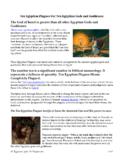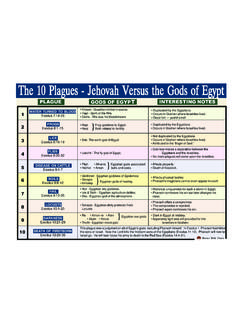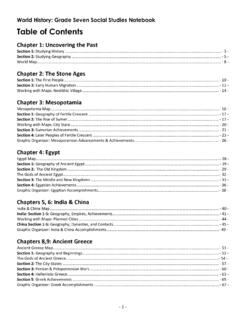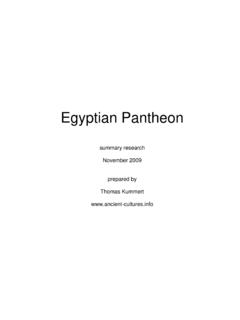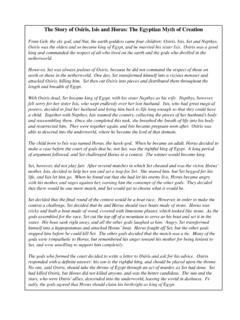Transcription of Egyptian Number System - Ontario Institute for Studies in ...
1 By: Sarah Austin, Kimberly Dixon, and Kaitlyn HeagleGoalsEgyptian Number SystemCurriculum Expectations: Grade 6 Materials 1 large whiteboard with Egyptian hieroglyphs down the left side 4 small whiteboards 6 whiteboard markers Chips for Bingo game Photos of ancient Egyptian hieroglyphs (Appendix B) Pre-made question cards for Bingo game (Appendix C) Mathematics: Number Sense and Numeration, Operational Sense, use a variety of mental strategies to solve addition, subtraction, multiplication, and division problems involving whole numbers To provide students with a basic understanding of the the Egyptian Number System Number Sense and Numeration, Quantity Relationships, represent, compare, and order whole numbers up to 1000000 Mathematical Process Expectations, Communicating, communicate mathematical thinking orally, visually, and in writing, using everyday language, a basic mathematical vocabulary.
2 And a variety of representations, and observing basic mathematical conventionsPossible ExtensionsLessonEgyptian Tic-Tac-Toe After sufficient practice with the Egyptian Number System students were ready to play tic-tac-toe. They were presented with 9 question cards, face up, in a 3 x 3 square (See Appendix C) Students work in teams of 2 to solve the problems on the question cards. If students correctly solve the problem, they get to place a bingo chip in the place of the card. The first team to make a line horizontally, vertically or diagonally wins the the code (15 minutes) Students were provided with the Egyptian symbol for a Number , and then worked collaboratively to deconstruct the System .
3 After the students successfully figure out how the symbols represented the given Number , the teacher presents a chart depicting each of the symbols. Students use their understanding of the patterns presented in the given Number to fill in the Number conversions for each symbol. Lesson (10 minutes) Show students pictures of how the ancient Egyptians recorded their history using pictures and symbols on the stone walls of their giant temples. Draw their attention to the 7 different hieroglyphs that the Egyptians used to represent their numbers. Have students compare and contrast the numbers in the stone to the symbols on the whiteboard and have them make predictions pertaining to what Number each symbol (5 minutes) Ask students where they think the Egyptian Number System originated from.
4 Ask students how they thought people would count if there was no Number System in place. Give a brief history (see Appendix A) Students can create their own question cards to be added to the tic-tac-toe game. Students could compare the Egyptian Number System with other ancient systems (ex. Chinese and Mayan Number Systems) Students could analyze the representation of numbers and non-numeric symbols to determine the meaning behind specific ancient Egyptian carvings. Students could create their own base-10 Number System using symbols or compare to a base 20 or base 60 Number System From around 3000 BC, The Egyptians had a writing System that was based on hieroglyphics, Hieroglyphs are little pictures representing words or numbers.
5 The Egyptians had a base 10 System of hieroglyphs for numerals. This means that they had separate symbols for one unit, one ten, one hundred, one thousand, one ten thousand, one hundred thousand, and one million. Appendix AAppendix BAppendix CBy: Sasha Reid, Serika Smith, and Vivian TrumblayGoalsEgyptian BingoCurriculum Expectations: Grade 6 Materials To teach students about the Ancient Egyptian Number System Mathematics: Number Sense and Numeration, Operational Sense, use a variety of mental strategies to solve addition, subtraction, multiplication, and division problems involving whole numbers Number Sense and Numeration, Quantity Relationships, represent, compare, and order whole numbers up to 1000000 Introductory script (Appendix A) One bingo card per student and enough chips to fill up each player s card (Appendix B) Sheets of paper representing each Hieroglyph and their Arabic numeral equivalent (Appendix C)
6 Story cards with challenge for when infinity symbol is drawn (Appendix D) Mathematical Process Expectations, Communicating, communicate mathematical thinking orally, visually, and in writing, using everyday language, a basic mathematical vocabulary, and a variety of representations, and observing basic mathematical conventionsLessonIntroduction (5 minutes) The teacher will ask students, What do you know about ancient Egypt? (See Appendix A for a detailed description of Ancient Egypt)Lesson (10 minutes) Give students the opportunity to learn and practice using the Egyptian Hieroglyphic Number System by printing each Egyptian hieroglyph with its equivalent Arabic numeral on a large sheet of paper Initially have the Arabic numerals hidden and have students guess what the different hieroglyphs mean.
7 Then present with the larger numbers in the base-ten model Once students demonstrate an understanding of the numbers through the ability to show various numbers as Egyptian hieroglyphs, then move onto the bingo gameActivity (15 minutes) Distribute bingo cards and golden bingo chips (See Appendix B) Introduce students to the game and how to use the additional resource provided (See Appendix C) Begin the game by drawing Egyptian numerals from a bag at random Intermittently throughout the game, infinity will be drawn At the drawing of the infinity card, the teacher would stop the game, choose a picture with a specific ancient Egyptian fact, and engage the students in a short non-fiction story about an Egyptian fact or figurehead.
8 After the story was told, the students were given a short numerical task to complete (See Appendix D)Possible Extensions Incorporate literacy by having students make up their own infinity cardsAppendix ALong ago, a civilization arose called Egypt. Egypt was located along the Nile River where there was very fertile land. Ancient Egyptians had a civilized life and invented many useful items for everyday use. Ancient Egyptians developed a writing System with pictures, called hieroglyphs. They used these pictures, at first, for special occasions to tell about what happened in their history.
9 Later, they used hieroglyphics for everyday records of numbers and counting. They would use the walls of buildings, leather and papyrus, which is a form of paper made from a plant, to write on. They would write down when floods and droughts occurred, what foods were grown, and which foods were needed. They would write down when rules changed, and when important events happened. For centuries, historians have studied ancient Egyptian hieroglyphs. They have found this picture writing on the insides of pyramids, on pieces of leather and papyrus. They believe Egyptians have used hieroglyphs since before 3000 Our first knowledge of mankind s use of mathematics beyond mere counting comes from the Egyptians.
10 Mathematics was used for measuring time, straight lines, the level of the Nile floodings, calculating areas of land, counting money, working out taxes, and cooking. Egyptians used pictures for letters and numbers. They developed their own mathematical symbols. A specific sign represented a Number . The Egyptians had a base 10 System of hieroglyphs for numerals. The ancient Egyptian civilization lasted for approximately 2,000 years. During this time, hieroglyphs changed in some ways. Like all cultures, the ancient Egyptians grew into a larger civilization that was influenced by different people and cultures around the BAppendix CKing Tut: King Tut was an Egyptian Pharaoh.





